The best electric heaters right now
There are several good reasons to buy a portable and Best Electric Heaters 2021 . For starters, they can be placed where central heating doesn’t reach, keeping that outbuilding or conservatory nice and toasty throughout the year. If you have a particularly cold house then an electric heater can be a good way to boost the temperature of a room, using it in conjunction with your existing heating.
Finally, an electric heater can be an effective way of heating just a single room, without having to run the entire central heating system in your home, which can be ideal in those periods where the weather is starting to warm. Electric heaters make sense in rarely used rooms, too, since they’ll often do a better job of warming such places to a working temperature more quickly than central heating.
The downside to electric heaters is the heat they produce will be lost quickly, and they can struggle to fill up larger rooms. As such, they’re better suited to small to medium-sized rooms, or for use with existing heating.
Here, we’ve rounded up the best electric heaters, taking in all types of model: fan heaters, convection heaters and oil radiators.
All use electricity, so efficiency remains the same across all models. The main differences come in the way that they work.
What to look out for when buying an electric heater
How to buy the right electric heater
If you know what you’re looking for, you can skip to our list.
- What do heat controls do? Heat mode selection is important, since it lets you adjust how hot the electric heater gets. As well as letting you cut down on running costs, it means you can adjust heat to suit the time of year and room: hotter on the coldest day and cooler when the outside temperature is warmer.
- Do I need a thermostat? A thermostat lets the heater turn off automatically when the set temperature is reached, helping keep a room at a comfortable temp. A proper thermostat will let you set a target temperature; an uncalibrated thermostat needs to be turned to maximum and then, when your room feels comfortable, dialled down until the heater cuts off.
- Are timer controls useful? If you’re using an electric heater as the only source of heating, timer controls let you programme when the heater comes on and off, much like your central heating. This is a good way to save money and only run the heater when you need it.
- What safety features do I need? There are two main safety features. Overheat protection ensures that the heater turns off before it becomes dangerously hot to prevent a fire. Tip-over protection turns off the heater if it’s knocked over, preventing damage to surfaces. The former features on all of the models here; the latter isn’t on all heaters. Typically, tip-over protection is best where it’s likely that a heater could get knocked over, such as with children or pets around.
- Can I use an electric heater with a smart plug? If you want to turn your heaters on and off with a smart plug, you need the right type of heating controls. Many of the smarter heaters only turn onto standby mode when the power is turned on, so a smart plug doesn’t work. Look for a heater with a dumb on/off switch: when the smart plug turns on the power, it turns on the heater.
- Can you use an electric heater with a smart thermostat? Not easily, but it can be done using an electrical relay and some rewiring. You’ll probably want an electrician to tackle the job for you, but here’s how to wire a smart thermostat to use an electric heater.
- The best electric heaters right now
- How to buy the right electric heater
- The best electric heater is the Dyson Pure Hot+Cool
- The best fan heater is the Dimplex MaxAir
- The best MeacoHeat Motion Eye 2.0kW Heater
- The best oil-filled radiator is the Swan Retro Oil Filled Radiator
- The best convector heater is the VonHaus 2000W Convector Heater with Turbo
- Fan heater glossary
Next, we have the list of the best electric heaters.
The best electric heater is the Dyson Pure Hot+Cool

Specifications
- Sleep timer
- Amazon Alexa, remote control and app operation
- Ten speed settings
- Oscillation
- Heat mode
Heater type: Purifying fan heater; Size: 764 x 248 x 248mm | Operation modes: Fan only, heat, purification | Heat settings: 1 | Thermostat: Yes (calibrated) | Safety features: Tip-over protection, overheat protection
Pros
- Quiet, automatic operation
- Smooth air output
- Reversible airflow
- Detailed display
- Excellent warming
Cons
- Few onboard controls
If you’re looking for a product that will be useful all year round, then the Dyson Pure Hot+Cool is for you. As you may be able to denote from the product name, this model can heat in the winter, cool in summer, and it’s a full air purifier all year round, keeping your indoor air cleaner.
As with other Dyson fans, this model is fully internet-connected, so you can control it with the Dyson Link app, a simple remote control and via the Amazon Alexa Skill (there’s currently no Google Assistant support). From the app, you can set a full schedule, including the fan mode (heat or cool) – and, in heat mode, the target temperature. For ad hoc use, you can simply turn the unit on and set your desired temperature, letting the fan do its job; it will turn off when the room’s at the right level.
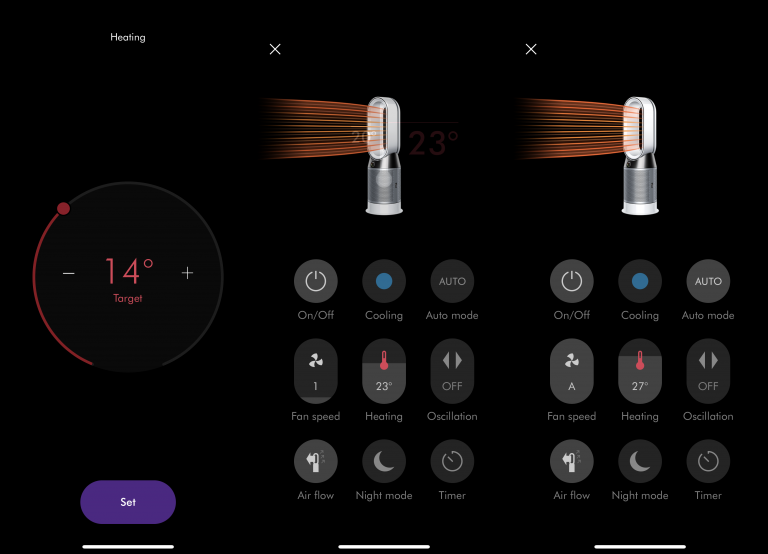
As with Dyson’s other fans, the Pure Hot+Cool is powerful in cooling mode and envelops you in a stream of warm air when you turn on the heat mode. We found that it soon warmed our garden office, and was the only source of heating we needed; for larger rooms, it’s a great way to add a bit of direct warmth.
Fan speed is impressive: at maximum speed, airflow was a powerful 3.7m/s at 15cm and 1.6m/s at 1m. Sound levels are low, too, and we measured the fan at 39.35dB (effectively background noise) on minimum speed. At maximum, the fan was just 57.6dB.
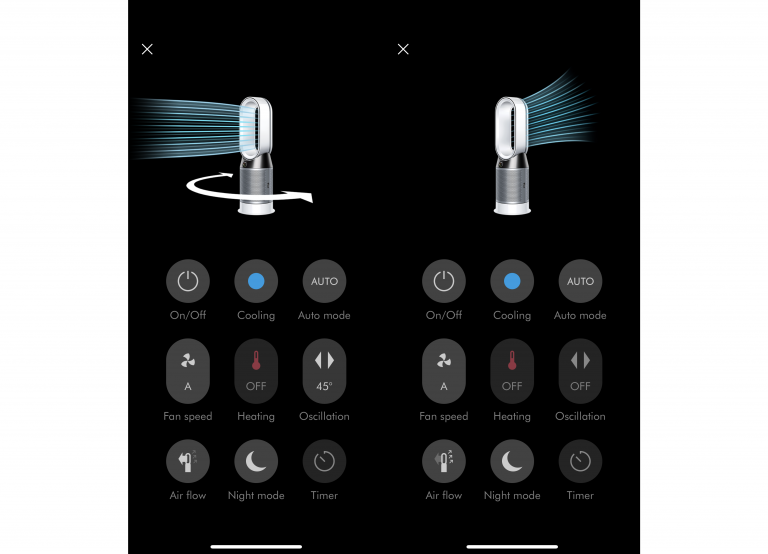
Air purification performance is excellent, and there’s a diffuse mode (cool air only) that blows air out of the rear of the fan so you can clean the air without having a stream of hot or cold air coming out.
The Dyson Pure Hot+Cool is one of the most expensive fan heaters on the market, but it’s effectively a three-in-one product, making it decent value. It’s also the smartest fan we’ve reviewed.
The best fan heater is the Dimplex MaxAir
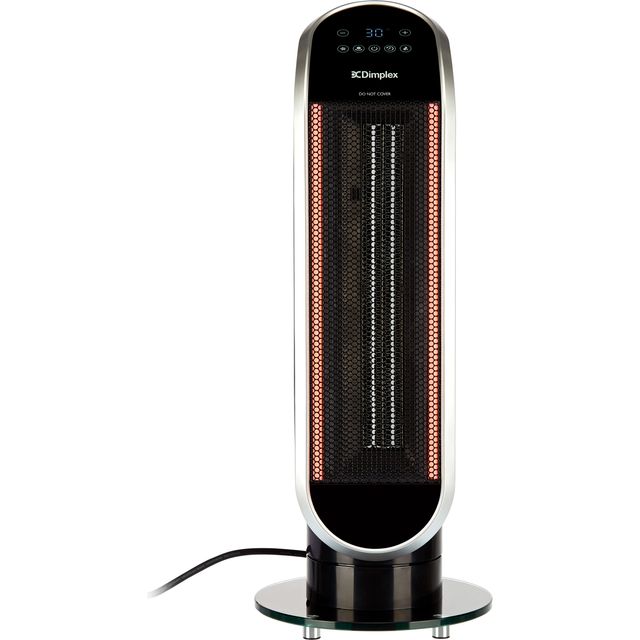
Specifications
- 69cm tall fan heater
- Remote control
- Three fan speeds, two heat levels
- 12hr timer, digital temperature setting
Heater type: Fan heater | Size: 690 x 270 x 270mm | Operation modes: Fan only, heat; Heat settings: 3; Heater power: 2.5kW; Thermostat: Yes (calibrated) | Safety features: Tip-over protection, overheat protection
Pros
- One of the strongest fans we’ve measured
- Incredibly effective heating
- Plenty of features
- Three-year warranty
- Remote control and Bluetooth app
Cons
- Expensive
- Quite noisy
- Needs a slower fan speed
The Dimplex MaxAir is a full-on tower fan, producing enough cooling air to cope with a summer’s day. However, if you need warming up then there’s also a 2.5kW heater inside it delivering top performance.
As well as being a versatile unit, the Dimplex MaxAir is also pretty attractive, so you’ll have no problem leaving this product out in your home throughout the year.
You can set the desired fan speed and, if required, the temperature using the simple on-body controls or via the provided remote control. There’s also a Bluetooth app, which lets you use your smartphone control when within range of the fan. The app provides the same controls, although they’re a touch easier to understand here.

Performance was excellent, with the fan producing some of the most powerful airflow we’ve seen; it maxed out at 5.7m/s when measured from 15cm. Heat performance was just as good, with the Dimplex MaxAir warming our test bedroom by the largest degree of any heater we reviewed.
The fan is a touch noisy on maximum at 44.9dB, so if you’re after a quieter unit then a convector heater might be a better choice.
With tip-over and overheat protection, this is a fan that’s capable of being left unattended without worry of any accidents.
The Dyson Pure Hot+Cool is slightly more flexible and looks neater, but it’s far more expensive, making the Dimplex MaxAir an excellent value alternative.
The best MeacoHeat Motion Eye 2.0kW Heater
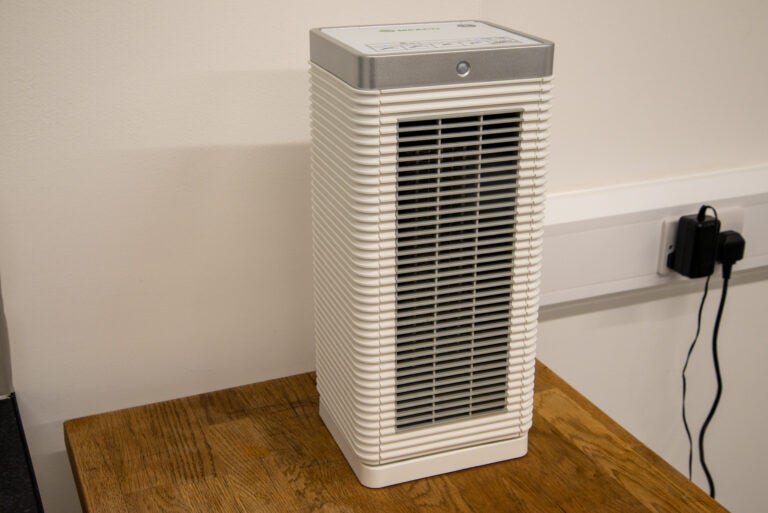
Specifications
- Fan heater
- 390 x 171 x 152mm
- Fan only, heat, motion modes
- 2 heat settings (1000 watts, 2000 watts)
- 2000W heater power
- Thermostat
- Tip-over protection, over-heat protection
We’re big fans of Meaco’s products and loved its 1.8kW small heater. With the Meaco MeacoHeat MotionMove Eye 2.0kW, the company returns with a higher power unit and an oscillation mode to help spread comfort around the room.
Pros
- Good performance
- Well priced
- Oscillation helps warm an entire room
Cons
- Styling is a little basic
- Motion sensor has limited range
The compact MeacoHeat Motion Eye 2.0kW Heater is one of the smallest electric heaters you can buy. The size and energy rating tells you that this is really a model designed for smaller rooms, or for working in conjunction with an existing heating source.
The top panel houses the controls, including two heat levels and a fan-only cooling modes. Unlike its little brother, the 1.kW Heater, this model also has a thermostat, so the heater will turn off when the temperature is reached. There are three heat modes (L, M and H), although there’s no corresponding temperature printed anywhere, so you may have to experiment.
This model also adds an oscillation mode into the mix, which lets you cover a wider area with warmth, which is good if you want to take care of multiple occupants.
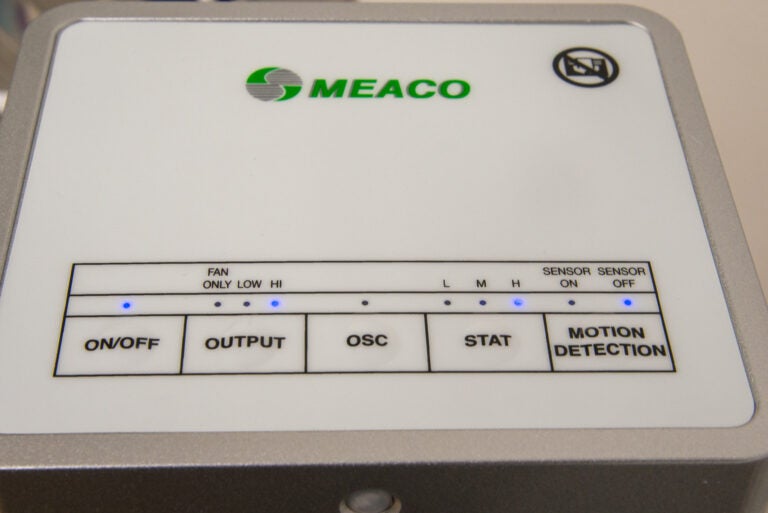
Unusually, there’s an IR motion sensor, which lets the MeacoHeat Motion Eye 1.8kW Heater turn on automatically when motion is detected. This could be useful in a rarely used room, such as a garage or other outbuilding. Positioning is important, though, as the MeacoHeat Motion Eye 1.8kW Heater has only a 1m motion detection range.
If you do want to leave the heater unattended, then tip-over and overheat protection keep things sage, even if the heater is knocked over.
A great occasional heater for small rooms or for boats and caravans that can take the peak 3kW power drain, the MeacoHeat Motion Eye 2kW Heater is a well-made and attractive fan heater.
The best oil-filled radiator is the Swan Retro Oil Filled Radiator
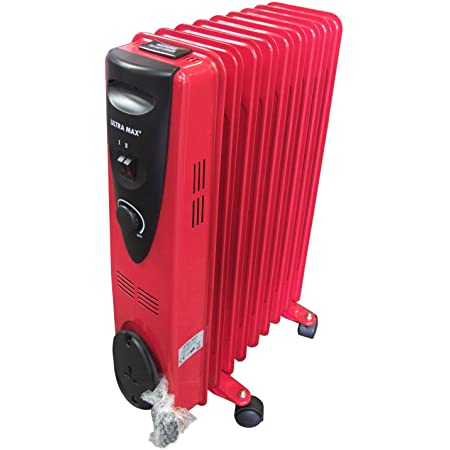
Specifications
- 65cm tall oil-filled radiator
- Three heat settings with thermostat
- 2kW rating
Available in eight colours, the stylish Swan Retro Oil Filled Radiator certainly draws the eye. The controls are basic and the heat output isn’t especially high, but it’s a silent and effective way to create and maintain an even temperature in a small room.
Pros
- Looks great – available in eight colours
- Almost silent
- Comparatively low power consumption
Cons
- Slow to heat up
- Not particularly portable
Swan Retro Oil Filled Radiator – What you need to know
- Heater performance – This radiator is slow to warm up and relies on convection to circulate warm air. It isn’t the best way to warm up quickly.
- Sound performance – There’s no fan noise; just a hint of trickling oil during the warm-up phase. Once hot the radiator is totally silent.
- Use and features – Just two dials mean this radiator is simple to use, but it lacks modern features such as a timer or remote control.
Swan Retro Oil Filled Radiator design – A stylish heater for any decor
This is far from the only oil-filled radiator you can buy, but it’s certainly one of the most stylish. Rather than a single flat slab, it comprises nine fins, linked top and bottom by pipework, and capped at one end by the heater and its controls. It’s appealing from the side or end on, and since it’s available in eight colours, it should fit well in almost any home.
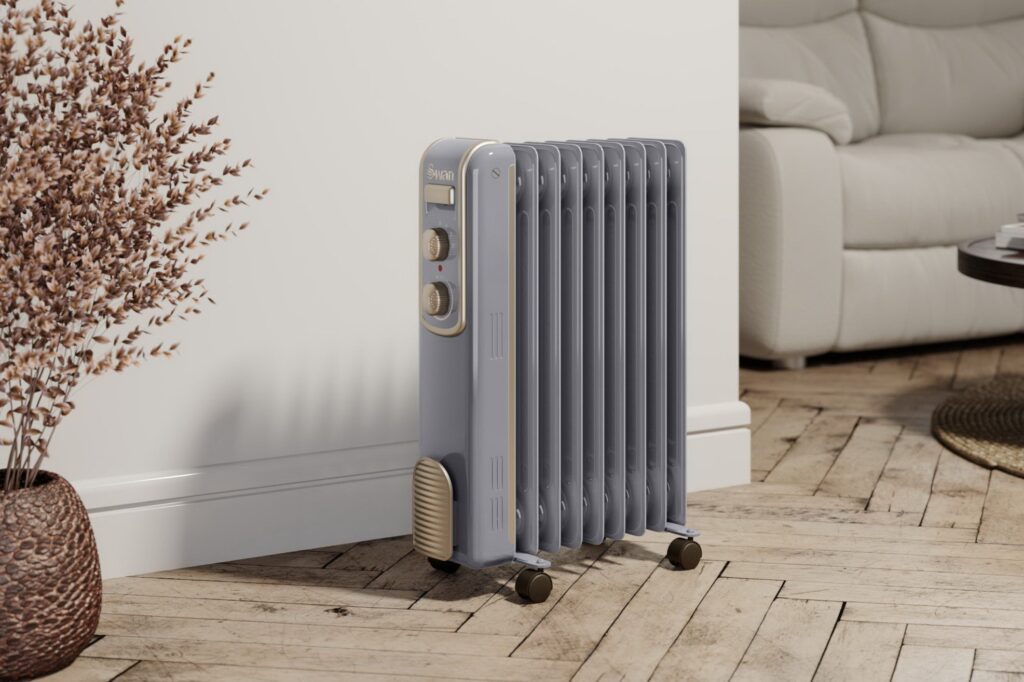
However, it won’t be suitable for all. It may not be unusually large, but it is very heavy, making it challenge to move around for people with reduced strength or mobility. It becomes super-hot, too, making it a poor choice around very young children who might be tempted to touch it.
If you’re after something that mimics a traditional wet radiator, the Swan Retro Oil Filled Radiator is a decent choice. This attractive radiator looks great and is also available in eight colours, so you can find the one that best suits your decor.
Wheels make it easier to move around, although we should point out that this model is heavy – and when turned on it’s too hot to reposition. As such, we’d advise getting the heater in position before you turn it on.
Controls are basic, with an uncalibrated temperature control that you’ll need to play with to find the ideal setting and a three-level power dial. There’s tip-over protection built in, but since the radiator maintains heat when it’s turned off, you may end up with some damage in the event of a knock-over.
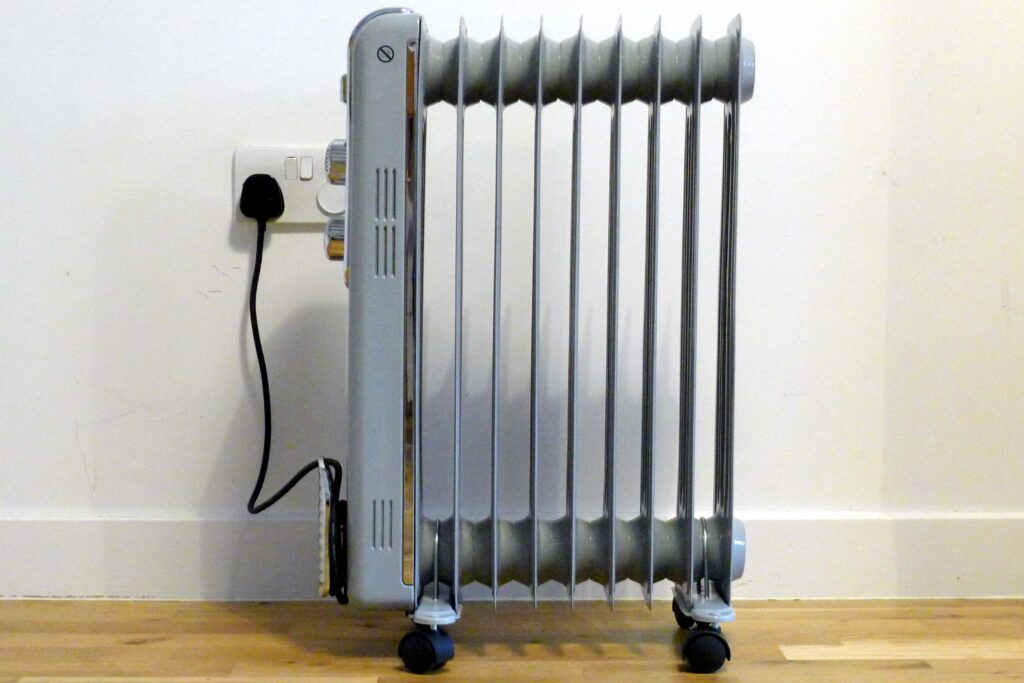
This radiator takes around five minutes to heat up, making a few clicking noises to start with before becoming completely silent. At full power, the radiator uses 2kW, but when the oil is hot, power throttles back to 0.8kW, making this radiator cheaper to run than many other electric heaters; the trade-off is that you don’t get as much heat out of it, and we measured the lowest temperature increase in our test room. As a result, this is really a product designed for small rooms.
Thanks to the oil inside, the radiator maintains heat for a good 30 minutes after it turns off, letting a room cool more slowly – more comfortable than a sudden temperature drop.
Despite the basic controls, the quiet operation makes the Swan Retro Oil Filled Radiator a good choice for small rooms.
The best convector heater is the VonHaus 2000W Convector Heater with Turbo
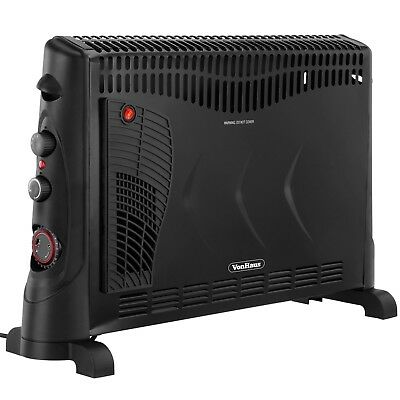
Specifications
- Heater type: Convector heater
- Size: 450 x 630 x 200mm
- Operation modes: Heat, Heat with fan
- Heat settings: 3
- Heater power: 2kW
- Thermostat: Yes (uncalibrated)
- Safety features: Tip-over protection, overheat protection
The VonHaus 2000W Convector Heater with Turbo is cheap, and pretty ugly with it. It does have a 24-hour timer, though, and proved remarkably effective in our tests. There’s no tip-over protection so we can’t recommend it for houses with pets or kids, but if you don’t mind the look and you want a convector heater that really works, this is a bargain.
Pros
- Cheap
- Easy to move around
- Effective
- Useful timer
Cons
- Ugly
- No tip-over protection
If you’re looking for a stylish electric heater, you may want to gaze your eyes further up this list, as the VonHaus 2000W Convector Heater with Turbo is a rather chunky unit. If the picture hasn’t put you off, then you’ll be pleased to learn that the questionable looks are offset by the low price and excellent performance.
As you may expect from a budget heater, controls are basic. There are three different heat modes and an uncalibrated temperature sensor: wait until the room feels comfortable then dial the setting back until the heater clicks off.
There’s also an old-fashioned mechanical timer, where you can use the 96 pegs to set when the heater turns on and off in 15-minute periods. It’s a pain to use, but handy if you want to use this as the primary heat source in a room. There’s overheat protection built in but no tip-over protection, so be careful where you use this radiator unattended.
The Turbo part of the name sounds exciting, but it’s just a small fan that pushes air out of the top of the radiator. It isn’t particularly effective, and you’re unlikely to need to use it; we preferred to use the VonHaus 2000W Convector Heater with Turbo in silent mode.
We found that this 2kW heater produced a temperature increase at about the maximum that we’d expect from a convector heater. Turning the fan on helps push air in a more directed way, although it means that you get less even heating with hotter parts of a room.
If you’re after a cheap and powerful convector heater for small to mid-sized rooms, the VonHaus 2000W Convector Heater with Turbo fits the bill. Note, it’s sold below as a Daewoo product.
VonHaus 2000W Convector Heater with Turbo – What you need to know
- Heater performance: This heater produces a strong waft of hot air, and that’s before you turn on the fan. The turbo won’t scatter your loose papers, but it’s enough to circulate heat more effectively.
- Sound performance: It’s easy to ignore the sound from the modest fan. Without it there’s just a gentle buzz from the elements.
- Use and features: The mechanical timer is a great feature for scheduled heating, but it can be fiddly to set. Everything else is simple to operate.
VonHaus 2000W Convector Heater with Turbo Design – A touch on the ugly side
If you want a small heater that blends into the background, stop reading here. The VonHaus 2000W Convector Heater with Turbo is reasonably big and looks a bit like a bad attempt at a gaming PC case. There are huge vents at the top, wide feet at the bottom, and a fan grille on the front panel that looks like a child’s swimming flipper.
There is a power dial on the left side of the heater, along with a temperature dial, power lamp and an electromechanical 24-hour timer that allows you to schedule heating periods. I’m not sure why, but the fan control switch is on the front panel.
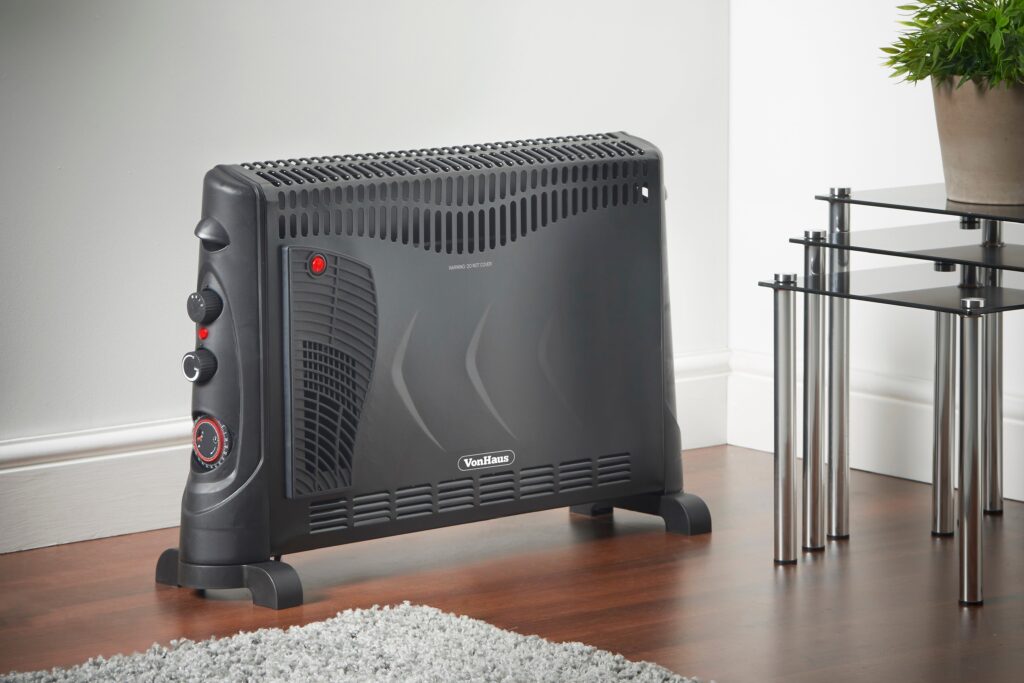
The heater arrives without its feet. Fitting them is a five-minute job using the six supplied screws, but even after checking that I had done it properly, the heater had a slight wobble on hard floors. On our sample, there was one place where the rear panel hadn’t been properly clipped in, but I’m confident this was a one-off manufacturing fault.
Fan heater glossary
Fan heaters
These have a heating element and a fan, blowing hot air around. This can help with circulating heat, and lets you direct it where you want heat – to a sofa where you’re sitting, for example. However, typically fan heaters don’t cover a room as thoroughly, so you can get warm pockets, and drafts can interrupt the flow.
Convection heaters
These have a single heating element and no fan, so they’re silent. They warm cold air coming in, which rises to the top of the room. The result is that it can take longer to see a difference than with a fan heater – but a room will be more thoroughly heated, improving comfort, than with a fan heater.
Oil-filled radiators
These warm the oil inside them to produce heat. The upside is that radiator continues to emit heat even after it’s been turned off, much like with a traditional water-filled radiator. The main benefit is that your room will more slowly cool, whereas you’ll notice an immediate cooling when using a fan or convector radiator. The downside is that you have to wait longer for the radiator to warm up, and therefore for the room to reach your desired temperature.
- Best electric heater : Dyson Pure Hot+Cool
- Best fan heater: Dimplex MaxAir
- Best smart heater: Meacoheat Motion Eye 2.0kW
- Best oil-filled radiator: Swan Retro
- Best convector heater: VonHaus 2000W with Turbo
SanDisk Ultra Dual 16GB USB 3.0 Pen Drive (Black)

